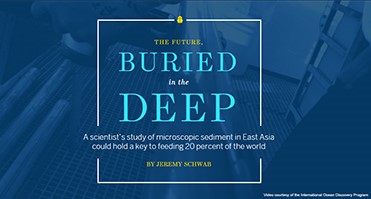Geological Data Derived from Seafloor and Subseafloor Samples Can Be Used To:
- Understand past climate change for environmental prediction.
- Assess benthic habitat.
- Assess offshore pollution patterns for sustaining healthy coasts.
- Find sources of dredged material for beach replenishment.
- Locate strategic offshore mineral resources.
- Assess the impacts of offshore geohazards.
- Determine suitable sites for offshore infrastructure (e.g., wind turbines).
- Ground-truth acoustic and other remotely sensed mapping data.
- Learn more about Earth and how its environmental systems function.
Media
- The Future Buried in the Deep: A scientist's study of microscopic sediment in East Asia could hold a key to feeding 20 percent of the world
- NSF Press Release 09-089 Sea-floor Sediments Illuminate 53 Million Years of Climate History
- Why Collect Rocks? An Overview on Geologic Objectives for the NOAA Okeanos Explorer 2015 Hohonu Moana Expedition
- Downloadable Two-Page Circular: Marine Geology

Why are geological data from the seafloor and subseafloor environments important to NOAA's Mission?
NOAA's Mission
Science, Service, and Stewardship: NOAA strives to understand and predict changes in climate, weather, oceans, and coasts, to share that knowledge and information with others, and to conserve and manage coastal and marine ecosystems and resources.
Climate Adaptation and Mitigation
Seafloor and subseafloor geological material provide an invaluable resource to understanding past climate conditions and changes. For example, finely varved sediments from areas of rapid deposition provide a high-resolution record of past climate variation. Similarly, volcanic ash layers contribute to the comprehensive study of climate change on relatively short timescales. The analyses of sediment and rock for components such as carbonates and isotopes provide baseline information for global modeling of climate and environmental change.
Healthy Oceans and Resilient Coastal Communities and Economies
The physical properties of the seabed (i.e., its geologic character) are key factors in evaluating benthic habitat for fisheries. To quote from a September 1999 technical memorandum issued by the National Marine Fisheries Service:
"The texture of surface sediments, defined as the size-frequency distribution of unconsolidated grains, is an important attribute of the coastal ocean environment. In addition to purely geological applications, data of this type have great utility in habitat studies seeking to explain the distribution and abundance of important biological resources.”
“The relative distribution of grain sizes affects sediment properties such as porosity, permeability, and resistance to displacement (Allen 1985, Selley 1988). These properties, in turn, may directly (e.g., self-burial to reduce exposure to predators) or indirectly (e.g suitability for essential prey organisms) affect fish habitat quality, as measured by rates of growth, survival, reproduction, and recruitment." (Smith, K.R. and R.A. McConnaughey, 1999. Surficial sediments of the eastern Bering Sea continental shelf: EBSSED database documentation. U.S. Dep. Commer., NOAA Tech. Memo. NMFS-AFSC-104, 41 p.)
The geologic character of the seabed also underlies many other blue economy activities:
"In addition to key environmental analysis and assessment roles, seafloor studies have other economic value. Sediment properties are crucial in placement of seabed cables, data from exploratory wells is necessary to evaluate sites for offshore drilling, and geochemical studies are necessary for evaluation of offshore hard mineral resources." (Our Seabed Frontier: Challenges and Choices, 1989. National Academy of Sciences.)
NCEI Marine Geology Sites
Help
Contact geology.info@noaa.gov with questions about marine geology data, collection, mapping, and other initiatives.
